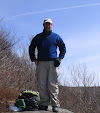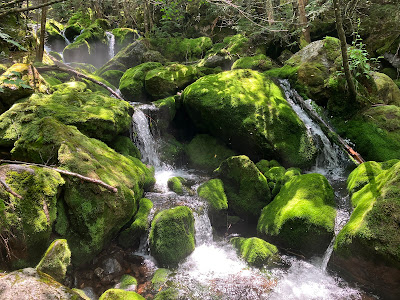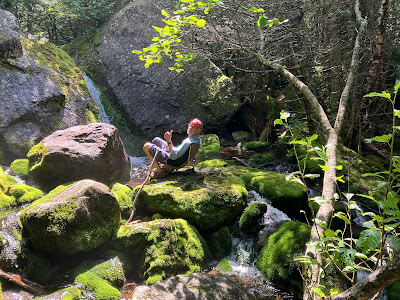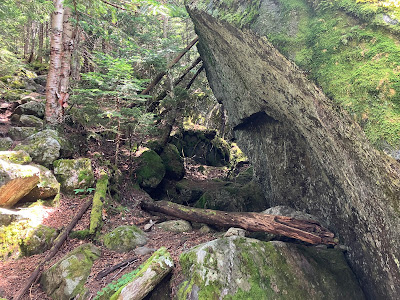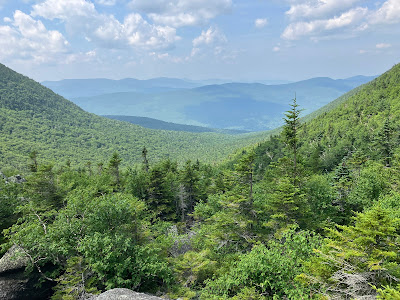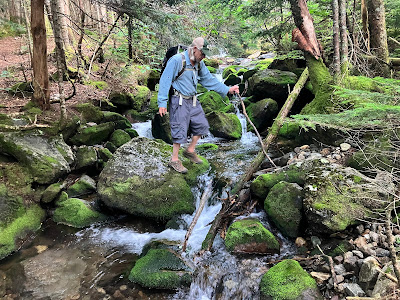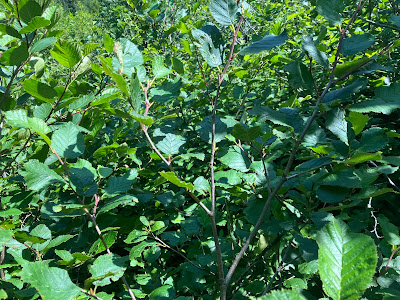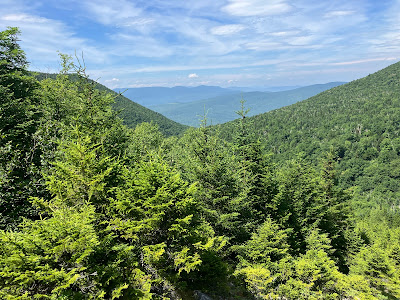Another trip to the Northern Presidentials, this time to enjoy a cool walk on the floor of Castle Ravine on a hot, sunny, humid day. I bushwhacked to a familiar pair of old slides on the west wall of the ravine for some views, then returned to the trail, went a bit farther up the ravine, and ascended the notoriously steep and rough section of The Link that goes up to the Castle Trail. The lower 3.5 miles of Castle Trail provided a descent route back to the trailhead.
Mount Jefferson and The Castles were looking good as I set off mid-morning on the Castle Trail.
I was surprised to see that the powerline crossing had recently been weed-whacked.
After crossing the Israel River on slippery rocks, I ran into the volunteer adopter for Castle Trail (senior moment - name forgotten) and his faithful dog, Ellie. He had been cleaning drainages and doing some brushing. That's a lot of trail to maintain - thank you!
Nice hardwood stroll on the next section of Castle Trail.
Streamside scramble on Israel Ridge Path.
The cool waters of Israel River.
A Presidential path less travelled.
After a crossing of Israel River (despite low water level, I used crocs due to awkward slippery rocks), I made a short bushwhack to see the Forks of the Israel, where Castle Brook (R) and Cascade Brook (L) unite to form the Israel River.
Shortly after another tricky crossing, I came to the much easier third crossing on Castle Ravine Trail, a lovely spot with cascades above...
...and below.
The trail crosses over this debris flow levee deposited by an old slide, either from the November 1927 storm or the September 1938 hurricane.
The overgrown track of the old slide comes right down to the trail.
A serene stretch of trail alongside the brook.
A debris flow levee from another old slide, just off trail on the other side of the valley, at the fourth crossing.
After the fourth crossing, the Castle Ravine Trail ascends along the lower flank of Israel Ridge, passing this peek up at the steep wooded wall of the lower Castellated Ridge.
Very nice section of trail.
At my chosen locationt to bushwhack to the two parallel slides on the west wall of the ravine, I dropped down a steep slope and crossed Castle Brook at this attractive open spot.
This Google Earth screenshot shows how the two slides appeared in 1999. The slide on the right was fresh, probably having fallen in 1995. The slide on the left fell around 1970. Curiously, the newer slide is almost completely revegetated now, while the older slide still has a sizeable open area..
I had gotten good views of the Castle Ravine headwall from the 1995 slide back in 2009. After crossing Castle Brook, I pushed into the dense deciduous growth that has overtaken this slide track, seeking any remaining hint of a view.
The alder growth is something to be reckoned with.
I did find an opening where I could see over the shrubs, here looking at Israel Ridge and the craggy viewpoint known as Emerald Bluff.
And there still was a vista up to the headwall of Castle Ravine.
Zoomed.
I thrashed farther up through the brush...
...hoping this track would open to the sky.
It looked promising, but didn't deliver.
Time to push across the slope to the vintage 1970 slide.
That's more like it.
A northerly view from the top of the open slide.
(L to R): The long east ridge of Mt. Waumbek, South and North Weeks with Mt. Cabot peering over between them, Unknown Pond Ridge, Rogers Ledge and Deer Ridge. Long Mountain faintly visible in the distant haze.
I spent an hour here relaxing in the sun with a nice breeze and minimal bugs.
An excellent sitting rock.
One of several white pines that have seeded in on the slide.
An even better view from the lower part of the slide, with Mt. Bowman on the left.
Peering up at The Castles on Castellated Ridge.
A roadblock on Castle Brook.
A cozy nook in the ravine.
A fern glade traversed while climbing back to the trail.
I continued farther into the ravine, passing the lower junction with The Link.
This area has a primeval feel to it.
Junction with the Emerald Trail, which climbs steeply to the fabulous viewpoint at Emerald Bluff on Israel Ridge.
On to the notoriously steep and rough climb up the southwest wall of the ravine to the Castle Trail on Castellated Ridge.The six-mile section of The Link extending from Appalachia to the Castellated Ridge was opened by the great trail-builder J. Rayner Edmands in 1893. The section from Castle Ravine up to the ridge was sometimes referred to as the "Old Link."
Here are a few of the "greatest hits" from this seldom-traveled section of The Link.
Wild and rugged.
A somewhat sketchy spot crossing a drainage.
Mossy rocks galore.
Classic Link terrain.
Partway up, a restricted view.
Onward and upward.
A full body workout.
Yikes!
Near the top was what I thought was the trickiest spot,
I was happy to see this sign at the Castle Trail junction.
The upper mile of the descent from here on Castle Trail is some of the nicest walking in the Presidentials - fern-lined with good footing.
But you can't get down off a Presy ridge without paying the price of admission.
A long section of steep descent.
Going up, this huge boulder marks the start of the steep stuff.
Farther down, a gorgeous hardwood forest.
Good drainage cleaning work by the trail adopter.
Mt. Jefferson at dusk.
